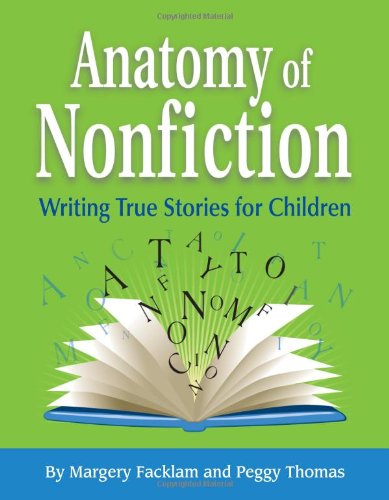Review of Anatomy of Nonfiction
Writing True Stories for Children
by Margery Facklam and Peggy Thomas
Contents
| Comments | To Buy
Purple
Crayon Bookstores
Book
Reviews Index Page

|
|
Margery Facklam and Peggy Thomas are a mother and daughter who both write nonfiction for children. Between them, they have published dozens of books and many magazine articles, making them very well-qualified to write on this subject. They have produced the only guide to writing nonfiction for children that I know of--that it is also an excellent and comprehensive guide is a plus.
I've edited many nonfiction books, from picture book to middle grade and beyond, so I approached this book from the perspective of an editor and wanted to see if it provided the guidance and information my experience had taught me that nonfiction writers would need. Of course, the world of children's nonfiction is a fairly small one, so I do know both of the authors, but I've tried to provide a description of the book in what follows, as well as my opinions, so you can determine if it's a book that will be useful for you.
| Let people know: |
Contents of Anatomy of Nonfiction: The book begins with an introduction to the field, covering what nonfiction is, explaining "creative nonfiction," and discussing what nonfiction writers do. The authors also explore the different segments of the market--trade books, magazines, mass market, educational, and electronic--recent history, and relevant industry awards.
Chapters on research and writing are a large part of the book, as they should be. Facklam and Thomas not only provide information on how and where to do research, both for information and illustrations, but also give substantial help on the crucial process of setting up and conducting interviews, something all nonfiction writers have to do in order to get up-to-date information and interesting anecdotes from experts and practitioners in a particular field. Following the research chapters come two chapters on writing, which include storytelling techniques and tips on particular elements of nonfiction, from titles to endings to sidebars.
Then come that look at particular types of nonfiction. There's one on biographies, one on science and nature writing, and one on "how-to." They follow these up with tips for getting feedback and improving one's early drafts.
Comments: I don't have much to say about Anatomy of Nonfiction, because it does such a great job of passing on insider knowledge. Someone with only general knowledge about writing will find the information and "best practices" they need right here--the chapter on interviewing is worth the price of the book by itself. Anecdotes from their own experiences and from other writers both liven up the information and provide concrete examples: for example, they give an excerpt from an actual interview and then show how it was used in print, or show us Russell Freedman's warts-and-all portrayal of Abe Lincoln in his highly regarded biograpy of him, matched with a nonfiction editor's comment about what he looks for in a manuscript.
Who Needs Anatomy of Nonfiction: If you write nonfiction for children, or want to write nonfiction for children, you need this book. It's aimed more at beginners and the "on-the-verge" crowd than published writers, but will be useful as a reference book for just about anyone writing NF for children, regardless of experience. It covers both book and magazine article writing, and even includes suggestions for producing both as part of the same project.
Where and How to Purchase Anatomy of Nonfiction:
- Anatomy of Nonfiction at the Institute for Writer's Bookstore. I understand from Peggy Thomas that it may go out of print soon, but for now it is available here.
Disclosure: I received a review copy of this book free of charge from the publisher, as do most reviewers. I also earn commissions on purchases of books via links on this site, as explained on my policy page.
This review is copyright © by Harold Underdown ( Google + Profile ). If you wish to reproduce it, please see the Terms of use. Last modified 7/08/2017.